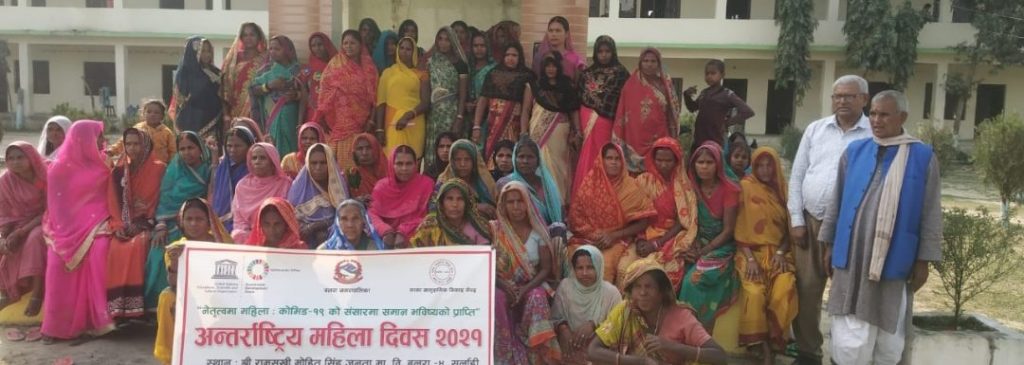Introduction to the Community Learning Center
The UNESCO Asia-Pacific Program of Education for All (APPEAL) defines a Community Learning Center (CLC) as a local institution that specifically serves rural or urban areas outside the formal education system. A CLC is usually set up and managed by native people themselves to provide the masses with opportunities to learning new skills and renew the existing ones for community development. The ultimate goal is to improve upon the quality of their lives.
In Nepal, the CLC is a well-recognized grass-root level non-formal educational institution which provides the local communities with opportunities to learn new skills, continue life-long learning, encourage literacy and education of adults, and equip themselves with income-generating skills. The main objective of a CLC is to create “learning opportunities” to the local people for their social transformations and sustainable livelihoods. The CLC is managed by the local community members with due technical and financial supports from the Government of Nepal.
The CLC encourages life-long learning, commitment to environment protection, and favorable attitude toward preservation of tangible and intangible heritages. It promotes the indigenous knowledge and skills and links these self-renewals with income generation of the local people. Respecting human rights and social diversities, the CLC focuses on the haven’t disadvantaged communities, vulnerable people, and those groups deprived of a dignified life so far. Thus, the CLC not only promotes and protects the contemporary socio-cultural norms and values of the present generation but also creates avenues for passing them along to future generations.
1. Constitutional, Legal and Policies Mandates for the CLC in Nepal
1a. Constitutional Mandate
As mentioned in the Constitution of Nepal, Part-4, Directive Principle of the State, Article 51-(j) 4, the CLC is mainly “… to establish and promote community information centre and library for personality development of citizen”(p. 25).Thus, the CLC has legal bases for serving the local community and enabling the native people to generate and disseminate knowledge for self-governance and social development.
The Education Act, 1971 (8th Amendment, 2017) Article 11 further states that the Government of Nepal can open and support CLC work for literacy, skill development, and continuous learning in community throughout the nation.
1b. Educational Regulations and Guidelines
The Education Regulation (2003), Rule 192, the Ministry of Education, Science and Technology (1) amended the 2006 guidelines for operation and management of the CLC and (2) redefined the overall framework of CLC, including its operating procedures, governing structure and scope, role and responsibilities, in 2014and developed the new criteria in 2021, The guidelines and criteria also made the provision for running at least one CLC in each ward of every urban/rural municipality. As of today, there are 2,151 CLCs in operation in Nepal.
1c. CLC Structure
The Constitution of Nepal (2015) assigns the complete responsibility of the governance and management of school education and all types of non-formal education to the local governments. The Local Government Operation Regulation 2017 specifies the role and responsibilities of the local government in managing the early childhood education and development, basic and secondary education, parental education, non-formal education, life-long learning, open, distance and alternative learning, community learning, and special education. Hence, the CLCs legally come under the jurisdiction of the local government of Nepal.
1d. Educational Policy 2020
According to the Educational Policy 2020, there shall be at least one CLC in each ward of a Municipality to develop and/or strengthen a hub for literacy, continuing education, life-long learning, community library, community communication and information center. Consequently, the government and non-government organizations have been making uses of the existing CLCs in promoting and protecting the tangible and intangible cultural heritages, local languages, indigenous knowledge and skills, environment, social harmony, peace, human rights, and all kinds of social inclusions (e.g., age, caste, gender and religious).
2.Functions of the CLC
2a. Educational Function
i. Supporting enrolment, teaching-learning, and education efficiency, adult literacy, continuing education
ii. Conducting skill-oriented vocational training and
iii. Conducting awareness campaign related to woman empowerment, civic consciousness, conservation of environment, epidemic, calamities
2b. Communication and Information Function
i. Developing posters, pamphlets and booklets related to health, family planning, nutrition and environment.
ii. Conducting exhibition and conference with the support from government and non-governmental organization and
iii. Conducting development-oriented programs with mobilizing the local communities and participation
2c. Community Development Function
i. Conducting short term skill-oriented training and refresher on the demand of young.
ii. Managing educational scholarship
iii. Managing training for development project to establish and promote government program and
iv. Mobilizing human and economic sources for development
2d. Coordination Function
i. Conduction of Integrated development works in coordination with local government and other local organizations and
ii. Construction and developmental network
2e. Resource Center Function
i. Collection and demonstration of books, booklets, posters, audio and visual aids related to education, health, agriculture, and occupation.
ii. Conducting local library and work as a form of exhibit place to increase and promote development-oriented knowledge and skills.
iii. Conducting recreational program and work as a form of exhibit place by reminding social norm and value
iv. Developing local club and increase mutual relationship by participating in social interaction, games and sports and
v. Providing the facility of child care center for employed parents


